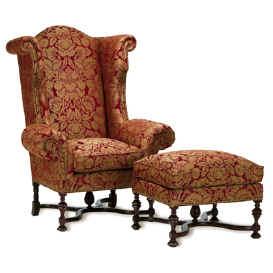William and Mary style furniture was inspired by the reign of William III and Mary II, who ruled England, Ireland, and Scotland from 1689 to 1702. William was from Holland, which explains the decidedly Dutch influence of William and Mary furniture. This interpretation of Baroque style was also influenced by French and oriental pieces. Like its predecessors, this style of furniture was uncomfortable by today’s standards, although upholstery techniques improved slightly.
The style developed in the Americas shortly after its appearance in Europe, thanks to a wave of immigrants fleeing England.
Wood
The most common woods for William and Mary style furniture were walnut, maple, and some oak. In the Americas, pine, apple, and sycamore were used for their ready availability. Mahogany also began to gain popularity around this time.
Characteristics
William and Mary furniture was more skillfully made than previous attempts. Chair backs, for the first time, were rounded slightly to fit the shape of the human spine. Rounded, carved tops caused this style to be softer in appearance than Jacobean works. Splayed, trumpet-turned legs gave pieces more stability and prevented the user from toppling over; craftsmen also started paying more attention to the feet of furniture. Decorative claw, hoof, ball, and bun feet were common; even cabinets, dressers and armoires were raised off the ground with decorative legs and feet. Furniture makers often used x-shaped stretchers to stabilize the legs of both tables and chairs.
Embellishments
William and Mary furniture is very decorative, although craftsmen eschewed the heavy, ornamental carvings that had been popular just decades earlier.
Marquetry was the most common form of decoration, which shells, leaves, and flowers taking center stage. Exotic woods, like ebony, were used in inlays. As techniques improved, many furniture makers began to use veneer.
Some pieces were painted or gilded; many were lacquered or “japanned.”
Hardware, once purely functional, became more decorative; it was often cast brass.
Upholstery fabrics were very decorative, typically colorful, and usually bearing formal floral or leafy designs. Embroidered tapestries were often used, as were silks, brocades, and velvets. Brass tacks with decorative heads secured the upholstery to the frame.
What to Look For
Gateleg tables remained popular throughout the reign of William and Mary, just as they had in the Jacobean era. Upholstered chairs, benches, and sofas became more common, and the easy chair (AKA grandfather, saddleback, or wing chair) made its first appearance. With William came many Dutch and French cabinet-makers, so storage pieces of the William and Mary period are especially high quality. Highboys and lowboys, desks, and storage armoires were favorites of this era.
Price
Authentic William and Mary furniture is not cheap, but many collectors are willing to pay a premium for these formal, elaborate pieces. A single banisterback chair can cost upwards of $2500. Expect to pay $10,000 or more for a small end table, more for an armoire or desk. Couches and loveseats can command $15,000 to $40,000, depending on their condition.
Images
William and Marry Style Armchair-Ottoman: Image is of a reproduction by Michael Fitzsimmons Decorative Arts
William and Marry Style Bannister Back Side Chair: Image from the Antique Associates of West Townsend.
William and Mary Style Settee: Settee is from Christies.com
William and Mary Style Armoire: Image from from Museumfurniture.com
William and Mary Style Desk: Image from from Museumfurniture.com

